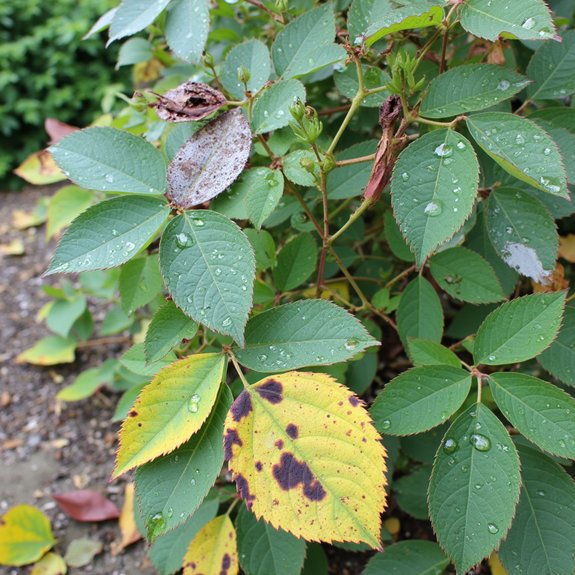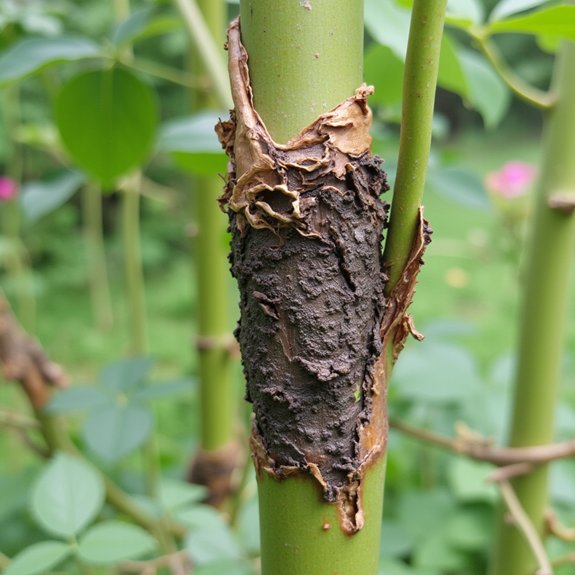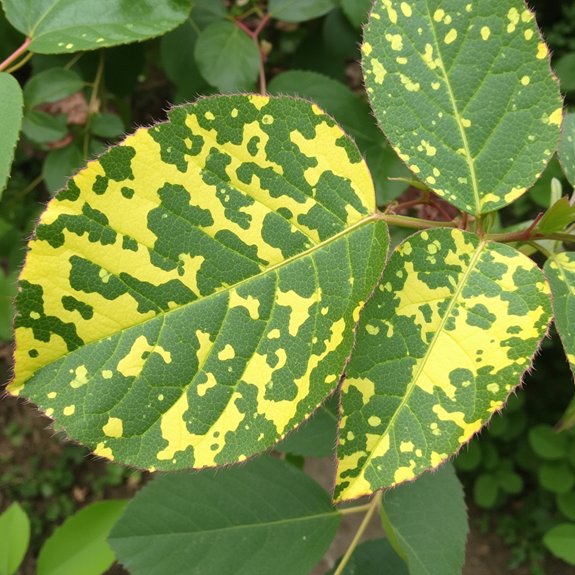Rose gardens harbor invisible enemies that strike without warning, often spreading undetected for weeks before symptoms appear. These silent attackers include fungal spores, viral particles, and bacterial infections that can devastate entire collections within a single growing season. Professional growers recognize that early identification saves both time and money, yet most home gardeners remain unaware of the subtle signs that precede total plant failure. The key lies in understanding how these threats operate.
Contents
- 1 The Silent Spread of Black Spot Disease
- 2 Powdery Mildew’s Deceptive White Coating
- 3 Stem Canker: The Wound That Keeps Growing
- 4 Rose Rust’s Underground Attack Strategy
- 5 Rose Mosaic Virus: The Master of Disguise
- 6 Anthracnose Leaf Spot’s Seasonal Ambush
- 7 Botrytis Blight’s Bloom Destruction Pattern
- 8 Downy Mildew’s Vein-Following Invasion
- 9 Rose Rosette: The Ultimate Garden Destroyer
- 10 Early Warning Signs That Save Your Garden
The Silent Spread of Black Spot Disease

Although black spot appears harmless at first glance, this fungal disease caused by Diplocarpon rosae spreads with alarming efficiency through rose gardens. The telltale circular black spots begin on lower leaves, creating yellow halos before progressing upward through the entire plant. Infected leaves eventually drop, weakening the rose’s overall health and vigor.
Effective rose care requires morning watering to allow foliage to dry completely. Proper spacing of 2-3 feet between plants promotes essential airflow, while spring pruning removes potential infection sites. Disease prevention also demands sanitizing tools between plants and removing all infected debris that could harbor overwintering spores.
Powdery Mildew’s Deceptive White Coating
Why do gardeners often mistake powdery mildew for dust or fertilizer residue on their roses? The white, powdery coating appears harmless, deceiving many into ignoring this serious fungal threat. Unlike dust, this coating doesn’t brush off easily and spreads across leaves, stems, and flower buds.
Effective powdery mildew treatment requires removing affected foliage immediately, then spraying healthy tissues with copper fungicide. Plant roses in full sun with 2-3 feet spacing for proper airflow. Water at soil level during morning hours to prevent moisture on leaves.
Consider investing in mildew resistant varieties to avoid future headaches and costly treatments.
Stem Canker: The Wound That Keeps Growing

Every experienced rose gardener has encountered them: those brown or purple lesions that appear around pruning cuts, slowly expanding along otherwise healthy canes. Stem canker develops when fungi like Leptosphaeria and Cryptosporella exploit wounds, creating discolored patches that threaten entire canes.
The damage begins subtly, often near pruning sites where fungal entry occurs most easily. These lesions gradually enlarge, weakening the structural integrity of affected canes.
Treatment requires decisive action: trim diseased canes five inches below visible canker damage. No chemical controls exist for this condition, making prevention through proper sanitation and healthy plant maintenance absolutely critical for long-term success.
Rose Rust’s Underground Attack Strategy
While stem canker attacks roses through obvious wounds and visible lesions, rose rust operates through a more deceptive strategy that begins beneath the surface. The Phragmidium fungus creates yellow spots on upper leaves while secretly developing orange to black pustules underneath. This hidden development allows widespread infection before gardeners notice symptoms.
Wind carries spores from these concealed pustules, spreading the disease rapidly during wet, mild conditions. Rust resistance varies among rose varieties, making careful selection essential. Prevention strategies include removing infected debris promptly, sanitizing tools between plants, and ensuring proper spacing for airflow to reduce moisture retention around foliage.
Rose Mosaic Virus: The Master of Disguise

How does a virus manage to infect roses while remaining virtually invisible to gardeners for months or even years? Rose mosaic virus earns its reputation as the ultimate stealth pathogen through remarkable camouflage abilities.
Infected plants often appear completely healthy, showing no obvious distress signals. Rose virus symptoms, when they finally emerge, include distinctive yellow patterns across foliage, creating mottled or distorted leaves that resemble artistic designs.
The mosaic transmission methods involve insect carriers, contaminated cuttings, and infected rootstock during grafting operations. Severe infections eventually reduce bloom production, forcing gardeners to remove weakened plants that no longer perform adequately.
Anthracnose Leaf Spot’s Seasonal Ambush
When does anthracnose leaf spot transform from a minor concern into a devastating rose disease? The answer lies in timing, as this fungal culprit strikes hardest during mild, wet conditions in fall and spring. Climbing, wild, and rambling roses face the greatest risk from Sphaceloma rosarum.
Seasonal symptoms begin as small reddish-tan to brown spots ringed in black on leaves. Complete defoliation follows if left unchecked. Anthracnose prevention requires vigilant pruning and disposal of infected foliage during vulnerable seasons.
Fungicidal sprays applied preventively can stop recurrence, but timing matters most for successful control.
Botrytis Blight’s Bloom Destruction Pattern
What transforms healthy rose blooms into mushy, deteriorating disasters within days? Botrytis blight strikes with devastating precision, targeting flowers and canes through wounded tissue. This fungal menace, caused by Botrytis cinerea, creates soft tan-to-brown specks on petals before turning entire buds into mushy failures.
The pathogen enters through cane wounds, establishing destructive cankers that compromise plant structure. Effective botrytis blight control requires immediate sanitation measures, including tool sterilization between plants and prompt removal of infected material.
Unfortunately, this resilient fungus often resists standard fungicide treatments. Bloom prevention depends entirely on maintaining pristine garden hygiene and removing damaged plant parts before infection spreads throughout the rose bush.
Downy Mildew’s Vein-Following Invasion
Unlike botrytis blight’s aggressive bloom attacks, downy mildew operates with surgical precision, following the natural highways of rose leaves. This sneaky fungus, Peronospora sparsa, creates yellow, brown, or purplish spots that trace along vein patterns like a roadmap of destruction.
The angular discolorations follow leaf veins methodically, distinguishing downy mildew from random spotting diseases. Wind, water, and contaminated tools spread spores efficiently between plants, making moisture management critical for prevention.
Mild, moist conditions fuel rapid spread, requiring immediate removal of infected plants when widespread. Though less common than black spot, downy mildew poses increasing threats to rose growers nationwide.
Rose Rosette: The Ultimate Garden Destroyer
Among all rose diseases, rose rosette stands alone as the most devastating threat that gardeners can encounter. This viral disease creates red, distorted new growth with thick, excessively thorny canes. Infected roses develop tightly clustered buds, distorted flowers, and stunted foliage.
Tiny mites spread the virus, often from multiflora roses nearby. Effective rose rosette management requires immediate action, no treatments exist. Disease prevention strategies focus on removing infected plants entirely, including surrounding soil within twelve inches.
Place all materials in tightly sealed garbage bags for proper disposal. This aggressive approach prevents spread to healthy roses.
Early Warning Signs That Save Your Garden
How does a gardener catch rose diseases before they devastate an entire garden? The answer lies in weekly monitoring during growing season. Effective rose care requires examining leaves from bottom to top, checking for circular black spots, yellow halos, or white powdery coatings.
Disease prevention starts with recognizing early symptoms. Look for discolored lesions on canes, especially near pruning cuts, and orange pustules on leaf undersides. Red, distorted growth signals serious trouble.
Weather patterns matter too. Wet, humid conditions following cool nights create perfect fungal environments. Document changes in plant health, noting dates and symptoms for future reference.
